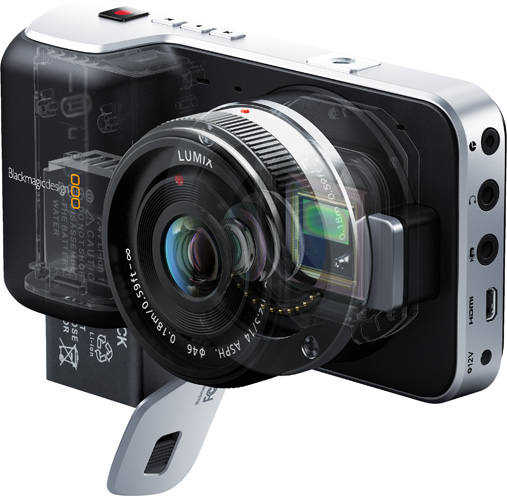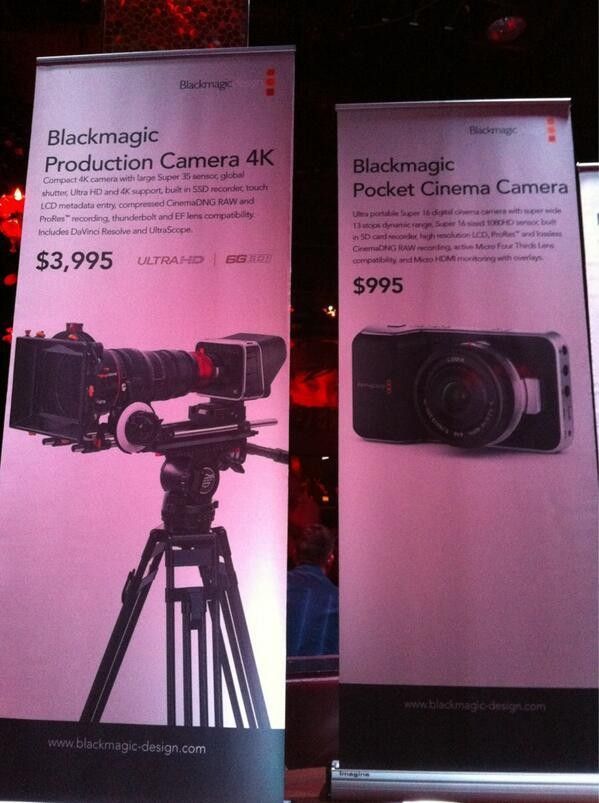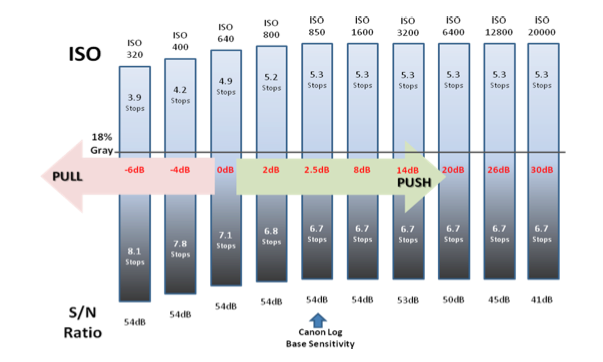A company in China has released it's own version of the Speed Booster for Nikon lenses designed to work with an NEX Sony E-Mount. There is no electronics in this adapter so don't expect it to control aperture or have auto focus capability with your lenses. Click the link below for details and the company's ebay page to purchase:
focal-reducer-speed-booster-adapter-Nikon-F-AI-AIS-to-Sony-NEX
A blog by Robert Cole. This blog is for those who are interested in the latest video and audio gear for film, video and sound production.
Thursday, 25 April 2013
Blackmagic Pocket Camera Footage!!!
So the wait is over. The first footage from Blackmagic's Pocket Camera is out in the wild and it looks really good. I find it has a very similar look to the 2.5k camera, which is great. All details regarding settings and lenses are embedded with the video below. Hopefully we will see more footage in the coming weeks but so far what I see looks very decent.
Blackmagic Pocket Cinema Camera - Market from John Brawley Tests on Vimeo.
Blackmagic Pocket Cinema Camera - Market from John Brawley Tests on Vimeo.
Thursday, 18 April 2013
Some great Blackmagic 2.5k test footage.
Check out some of this great blackmagic test footage shot on the 2.5k camera by my colleague Krista. The footage really demonstrates how well this cameras handles difficult shooting conditions like shooting against snow with bright sky. The dynamic range comes in handy when trying to compensate exposure in such conditions while still keeping a lot of detail. Notice how much contrast and detail come through in the snow. Click on the link below or download the file from Vimeo for best viewing quality.
BMCC/Anamorphic/ProRes from Ryan Glover on Vimeo.
BMCC/Anamorphic/ProRes from Ryan Glover on Vimeo.
Wednesday, 17 April 2013
The OmniRig: Just when you thought the MoVi system was cool. Wait till you see this stabilizer and its price.
So at NAB this year two things really stole the show. Blackmagic's announcement of two new cameras and the incredible new stabilizer "MoVi" from Freeflysystems a revolutionary new type of handheld stabilizer that makes the Steadicam seem some how now archaic. Vincent Laforet has a few great videos on Vimeo demonstrating just what this amazing rig can do:
MōVI BTS from Vincent Laforet on Vimeo.
MōVI from Vincent Laforet on Vimeo.
MōVI in Action (Quick Video) from Vincent Laforet on Vimeo.
Here is a detailed blog post from Vincent about what this system can do and why he thinks it is a total game changer:
MoVi: A revolutionary handheld stabilized system takes flight.
As good as the MoVi system is, the $15,000 price tag will be hard for many people to justify. Luckily there is another product out there from Limelite that is much cheaper and can deliver somewhat similar results.
The LimeLite OmniRig is a unique alternative to the MoVi. So here's the deal, there is no gyro with this system which makes it much, much cheaper. Coming it at under $2000 in July this stabilizer looks really interesting. Check out the video below to see it action.
The first video has some stabilization in post:
Single Shot Cinema: Camera flying through the window from 4Film on Vimeo.
Here is the second video without stabilization:
OmniRig - Flying Through Windows from Chris Turiello on Vimeo.
The post stabilization obliviously really helps to smooth out the scene but you can still see the potential of this device considering it is the first version and there is some time before it is released. With it's great price point I am sure many filmmakers will be taking a second look the OmniRig from Limelite.
For more info on this device click here: Limelite
MōVI BTS from Vincent Laforet on Vimeo.
MōVI from Vincent Laforet on Vimeo.
MōVI in Action (Quick Video) from Vincent Laforet on Vimeo.
Here is a detailed blog post from Vincent about what this system can do and why he thinks it is a total game changer:
MoVi: A revolutionary handheld stabilized system takes flight.
As good as the MoVi system is, the $15,000 price tag will be hard for many people to justify. Luckily there is another product out there from Limelite that is much cheaper and can deliver somewhat similar results.
The LimeLite OmniRig is a unique alternative to the MoVi. So here's the deal, there is no gyro with this system which makes it much, much cheaper. Coming it at under $2000 in July this stabilizer looks really interesting. Check out the video below to see it action.
The first video has some stabilization in post:
Single Shot Cinema: Camera flying through the window from 4Film on Vimeo.
Here is the second video without stabilization:
OmniRig - Flying Through Windows from Chris Turiello on Vimeo.
The post stabilization obliviously really helps to smooth out the scene but you can still see the potential of this device considering it is the first version and there is some time before it is released. With it's great price point I am sure many filmmakers will be taking a second look the OmniRig from Limelite.
For more info on this device click here: Limelite
Blackmagic Pocket Camera: What we know so far.
Last week at NAB Blackmagic stunned the film world again by announcing two new cameras. A new 4K APS-C camera with global shutter for $4000 dollars and a smaller Micro Four Thirds pocket camera for $1000 dollars. Personally I am more excited about the pocket camera. This price point will be great for a lot of people looking to get great dynamic range without having to pay a big price. Plus the fact it has a micro four thirds active mount will be good for those people who have MFT lenses or those wishing to add other types of lenses using an adaptor. Adding Nikon, Canon or even PL mount lenses will be easy with the right adapter. It's still very early but Blackmagic is saying a delivery time of July is what we can expect and that it will be released most likely before the 4K camera. I haven't seen any footage yet but hopefully they will release some test footage soon. If Anyone has found any footage on the web please send me a link.

In the mean time lets go through what we know about the camera and some of its features:
-It has 1920x180 resolution
-Apple 10-bit 422 200Mbps ProRes codec with the promise of lossless CinemaDNG codec that will be coming later with a firmware update.
-The sensor size is Super 16: Roughly (12.5x7.4mm)
-Frame Rates 23.98p, 24p, 25p, 29.97p, 30p
-Dynamic Range: 13 stops
-MFT (micro four thirds lens mount) which should give full aperture control to native lenses.
-Magnified focus for focus assist and peaking
-Removable storage is SDXC and SDHC cards. It can record in ProRes 50 minutes of footage on a 64Gb SDXC card
-Metadata: camera data and user data such as shot number, filenames and keywords
-Can output through HDMI without overlays for monitoring: Micro HDMI type D. HDMI Audio Output 2 channels 48 kHz and 24 bit
-3.5" LCD: 800 x 480 resolution
-2.5mm LANC control for controlling record, stop, focus and iris with active lenses
-3.5mm mic input
-3.5mm headphone jack
-0.7mm 12V power input
-Standard tripod mount top and bottom
-Computer Interface USB 2.0 mini B port for firmware updates
-Operating Temperatures 0° to 40° C (32° to 104° F)
-Humidity rating 0% to 90% non-condensing
-Removable battery: Rechargeable Lithium Ion Battery (EN-EL20) Battery Life: approx. 1 hour of continuous recording time. Charge Time: approx. 1 hour and 15 minutes when the camera is off and approximately 2 hours when in use. You can also use non Blackmagic batteries such as the easy to find and inexpensive Nikon EN-EL20 Rechargeable Li-ion Batteries. This is a big deal because on the 2.5k camera the battery was built in with lousy operating times.
-In the box you get: Blackmagic Pocket Cinema Camera, wrist strap, dust cap and 12V AC Adapter.
Plus, DVD (DaVinci Resolve Lite)
-Product Warranty 12 Month Limited Manufacturer's Warranty.
-Compatible operating systems are: Mac OS X 10.8 Mountain Lion or later Windows 7 or later
-Dimensions: 5.04 x 1.49 x 2.6 (128 x 38 x 66 mm)
-Weight: 12.52 oz (355 g)
So that's basically what we know so far. As for what the image looks like hopefully we will see some footage soon.


In the mean time lets go through what we know about the camera and some of its features:
-It has 1920x180 resolution
-Apple 10-bit 422 200Mbps ProRes codec with the promise of lossless CinemaDNG codec that will be coming later with a firmware update.
-The sensor size is Super 16: Roughly (12.5x7.4mm)
-Frame Rates 23.98p, 24p, 25p, 29.97p, 30p
-Dynamic Range: 13 stops
-MFT (micro four thirds lens mount) which should give full aperture control to native lenses.
-Magnified focus for focus assist and peaking
-Removable storage is SDXC and SDHC cards. It can record in ProRes 50 minutes of footage on a 64Gb SDXC card
-Metadata: camera data and user data such as shot number, filenames and keywords
-Can output through HDMI without overlays for monitoring: Micro HDMI type D. HDMI Audio Output 2 channels 48 kHz and 24 bit
-3.5" LCD: 800 x 480 resolution
-2.5mm LANC control for controlling record, stop, focus and iris with active lenses
-3.5mm mic input
-3.5mm headphone jack
-0.7mm 12V power input
-Standard tripod mount top and bottom
-Computer Interface USB 2.0 mini B port for firmware updates
-Operating Temperatures 0° to 40° C (32° to 104° F)
-Humidity rating 0% to 90% non-condensing
-Removable battery: Rechargeable Lithium Ion Battery (EN-EL20) Battery Life: approx. 1 hour of continuous recording time. Charge Time: approx. 1 hour and 15 minutes when the camera is off and approximately 2 hours when in use. You can also use non Blackmagic batteries such as the easy to find and inexpensive Nikon EN-EL20 Rechargeable Li-ion Batteries. This is a big deal because on the 2.5k camera the battery was built in with lousy operating times.
-In the box you get: Blackmagic Pocket Cinema Camera, wrist strap, dust cap and 12V AC Adapter.
Plus, DVD (DaVinci Resolve Lite)
-Product Warranty 12 Month Limited Manufacturer's Warranty.
-Compatible operating systems are: Mac OS X 10.8 Mountain Lion or later Windows 7 or later
-Dimensions: 5.04 x 1.49 x 2.6 (128 x 38 x 66 mm)
-Weight: 12.52 oz (355 g)
So that's basically what we know so far. As for what the image looks like hopefully we will see some footage soon.

Monday, 8 April 2013
Blackmagic Cinema Camera goes 4K!!!
So this is really early but it looks like Blackmagic is releasing a 4K version of their cinema camera with a larger sensor and global shutter refreshing on the chip for around $4000 US. They also appear to be releasing a smaller Micro Four Thirds pocket camera for $1000 dollars capable of doing 12-bit RAW recording as well. Check out the link below for more details. It's still early with lots more details to come but this could be very big news!
BMCC 4K with global shutter and Super 35 sensor.

Update: BMCC pocket cinema camera has been seen in the wild. Engadget has managed to get a picture of it here: Blackmagic's pocket cinema camera

BMCC 4K with global shutter and Super 35 sensor.

Update: BMCC pocket cinema camera has been seen in the wild. Engadget has managed to get a picture of it here: Blackmagic's pocket cinema camera

Thursday, 4 April 2013
Canon C100 with Atomos Ninja 2

Canon C100:
Last year Canon released a smaller watered down version of their popular cinema camera the C300. The C100 although similar, differed in a variety of ways to the bigger and more expensive C300, mainly being the codec it used. The Canon C300 records internally to dual CF card slots using an MPEG 2 MXF 50 Mbps 4:2:2 compression scheme. This is considered to be entry level broadcast for television. The C100 on the other hand uses a 24 Mbps 4:2:0 AVCHD codec to dual SD card slots. This codec is the main difference between the two cameras. Although AVCHD is a popular codec in the video world for professional and not professional cameras it is still not considered to be a true broadcast codec.
Like the bigger C300 the C100 also used the C-Log gamma curve. This gives back a little more flexibility to the AVCHD codec when it comes to the ability to grade in post. Although it is not RAW it does maintain some of those charistics for color correcting in post. C-Log gives a higher dynamic range with flat image quality and contrast. Working in post, this will provide you with more ability to adjust luminescence levels as well as color saturation and contrast. Better Chroma-Key capability and over all a more robust image when it comes to working in post.


Shooting in C-Log on the C100 is a great way to get a little bit more about of the AVCHD codec on the C100. It will not take you as far as using C-Log with the C300 codec but it gives you a bit more room in post to work with.
The price difference between the C100 and the C300 is substantial. With the Canon coming in at $14,700.00 Canadian and the C100 coming in currently at $5,669.00. Like I said before the main difference between these two camera's is the codec. The sensor and the processor are both the same. There are a few features lacking on the C100 such as an inferior viewfinder and smaller LCD screen as well as less dials on the on the body of the C100 to access the menu. All menu access is done through the grip on the C100. If you remove the grip then you lose access to the menu. The C100 also does not have any off speed frame rates. So no 60p at 1280x720 unlike on the C300.
If you can live with the lack of off speed shooting capability and the limited features discussed above than C100 still offers a great image for a much cheaper price. There is another way however to take this camera to the next level and unlock it's true potential.

By adding an external recorder like the Atomos Ninja 2 pictured above it is possible to get a broadcast quality signal off of the C100 in a codec that actually exceeds the internal codec of the C300. The Ninja 2 can receive an uncompressed signal via the HDMI output. The Atomos Ninja records to a 2.5 SSD drive in a couple of different codecs and bit rates:
The Ninja 2 supports the following:
Apple ProRes:
HQ - 220 Mbps
422 - 150 Mbps
LT - 100Mbps
Avid DNxHD
Avid DNxHD 220x -220Mbps (10-bit)
Avid DNxHD-220 - 36 Mbps (8-bit)
Avid DNxHD-145 - 36 Mbps (8-bit)
By using the Atomos Ninja in conjunction with the Canon C100 it is possible achieve a better codec then internally in the C300.
The Canadian retail price on the Ninja is currently: $1079.00
The C100 with Ninja is a good option that doesn't break the bank but yet delivers as good or even better compression for post editing and grading when pared with external recorder. Depending what you do with the footage in post the results may not be night & day compared to the internal AVCHD codec.
Check out these videos to see the results of the C100 pared with an Atomos Ninja 2 and you be the judge if it is worth spending the extra cash getting the Ninja for use with this camera:
Canon EOS C100 feats Atomos Ninja 2 engl. from Stefan Czech on Vimeo.
Canon C100 + Atomos Ninja 2 from reflejos|digitales on Vimeo.
Canon EOS C100 Test : Broadwater in Low Light (Atomos Ninja 2, Wide DR) from Matt Turner
C100 AVCHD vs Ninja 2 from Jason Silzle on Vimeo.
IBC 2012 - Canon EOS C100 is in love with the Ninja from cinema5D on Vimeo.
Canon C100 Test AVCHD vs ProRes from Adam Stevenson on Vimeo.
Canon EOS C100 AVCHD and ProRes 4:2:2 HQ Comparison from Rusty Auto Productions
Reedy River Falls Park / C 100 / Ninja 2 from Valdas Kotovas on Vimeo.
C100 Test AVCHD vs PRORES HQ from Francesco Corsini on Vimeo.
Links for more information on the Ninja 2 and the Canon C100/C300
Atomos Ninja 2
Canon C100
Canon C300
Labels:
1DC,
Atomos,
Atomos Ninja 2,
C-Log,
C300,
C500,
Canon,
Canon 4k,
Canon C-Log,
Canon C100,
Canon C300,
Canon cinema,
external recorder,
Gama curve,
HDMI,
Ninja 2,
SSD
Subscribe to:
Posts (Atom)
